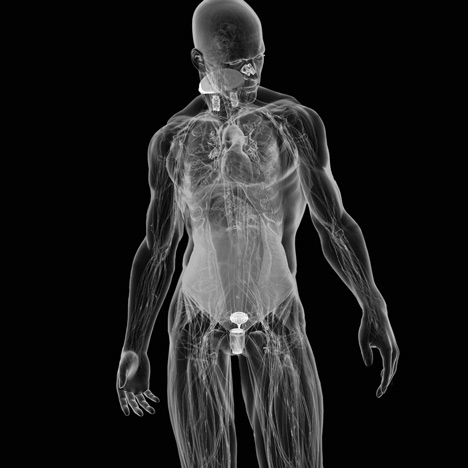When tasked with designing a water bottle for 100 year's time, Tokyo designers Takram instead came up with artificial organs to help the body use water more efficiently as drinking water becomes scarce.
The Shenu: Hydrolemic System includes inserts for the nasal cavity to retain moisture normally lost through breathing, heat-exchangers and a radiating colar at the neck to lower body temperature and reduce perspiration, and a urine condenser and faecal dehydrator to reclaim water from waste before it leaves the body. They also predict that food will be replaced by capsules of nutrients and hormones.
The project will be on show as part of art fair dOCUMENTA(13) at the Kunsthalle Fridericianum in Kassel, Germany, from 9 June until 16 September.
The details below are from Takram:
Tokyo based design engineering firm, takram design engineering, will be exhibiting their newest work at dOCUMENTA(13) in Germany. Their work, titled "Shenu: Hydrolemic System", was based on a theme to design a water bottle for the degenerated world a hundred years later. This artwork is a part of the group exhibition directed by a leading Korean artist duo, MOON Kyongwon and JEON Joonho.
A cathartic future in which many people and natural resources are lost due to the radioactive pollution and rising sea level. In this world in which potable water is extremely limited due to pollution, takram realized that it is impossible to devise a water bottle that is on a linear evolutionary trajectory of its current incarnation. Here takram proposes an entirely new line of products called "Shenu: Hydrolemic System" that includes the artificial organs as the water bottle of the future.
Takram is a design engineering firm of the new age that features a multilateral davelopment approach employing design and engineering perspectives. The techniques and methods developed by takram, such as design engineering, prototyping and storyweaving, were deployed successfully during it's realization process.
Related stories:
.
An inhaler for a future scenario where there’s not enough oxygen in the air for humans to survive »
Not-so-luxurious dwelling with an armoured shell, in case things turn nasty »
How New York might look as sea levels rise »
And what might happen to London »

